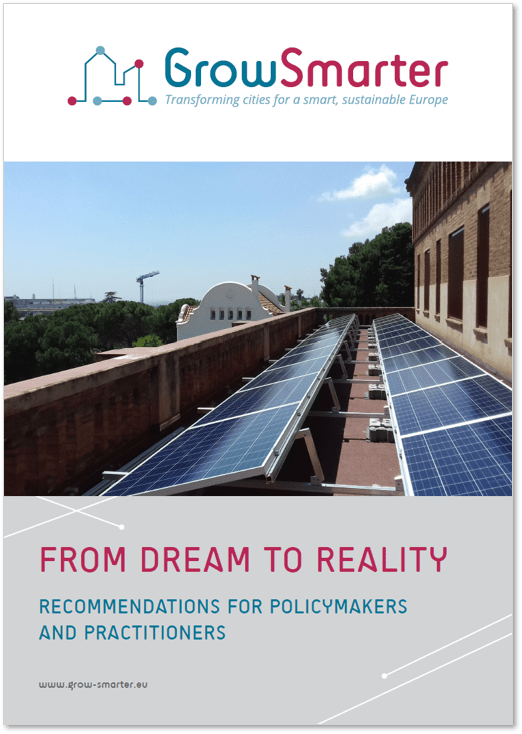The GrowSmarter project, funded under the EU’s Horizon 2020 Smart Cities and Communities programme, ran for five years and involved three Lighthouse cities (Stockholm, Barcelona, Cologne) and five Follower cities (Valletta, Suceava, Porto, Cork, Graz). Its main goal was to demonstrate smart city solutions across energy, infrastructure, and mobility sectors, with an integrated approach to economic, social, and environmental sustainability.
The project’s twelve solutions were grouped into three pillars:
1. Low Energy Districts
Energy use in buildings accounts for ~40% of total EU energy demand. GrowSmarter tackled this with innovative refurbishment techniques, targeting older building stock with:
-
Smart shell refurbishment: Upgraded over 120,000 m² of residential and tertiary floor space using insulation, low U-value windows (down to 0.7), and wastewater heat exchangers. Stockholm achieved 64% annual energy savings; Cologne 37%; Barcelona 30%.
-
Smart Home Energy Management Systems: These guided tenant behavior and showed up to 15% savings in electricity use. Tailored engagement strategies were critical for adoption, especially among elderly or tech-wary tenants.
-
Waste heat recovery and district heating: Innovative business models allowed the purchase of waste heat from supermarkets and data centers, which in Stockholm, could heat up to 1,000 apartments. This measure alone could save 200 GWh annually if scaled.
Economic feasibility varied by climate and building size, with cold climates offering higher ROI due to greater energy savings.
2. Integrated Infrastructures
GrowSmarter explored the synergy between traditionally siloed urban systems (energy, waste, transport, communication) using digital tools and IoT:
-
Smart street lighting: LED lighting controlled via sensors, timers, and remote access achieved up to 31% energy savings. Posts doubled as telecom sites, EV chargers, or public Wi-Fi points.
-
Smart waste collection: Optical sorting systems using colored bags and underground piping reduced traffic by 90% and CO₂ emissions by 71%. Recyclable fractions increased and residual waste fell by 66%. Biogas from organic waste powered local public transport.
-
Big Open Data Platforms: City-wide systems in Cologne (UrbanPULSE), Stockholm, and Barcelona enabled real-time monitoring, scenario simulations, and citizen feedback loops. Barcelona’s platform operated as Platform-as-a-Service, offering a marketplace for new urban services and applications.
Challenges included data protection (GDPR compliance), organisational alignment across city departments, and ensuring economic feasibility in early adoption stages.
3. Sustainable Urban Mobility
Cities trialed various smart mobility approaches to reduce transport emissions and increase accessibility:
-
Last-mile delivery: Cargo bikes and delivery rooms reduced fossil-fuel use and urban congestion. For instance, Stockholm’s delivery rooms allowed 24/7 parcel drop-offs via smart locks, replicated later by PostNord.
-
Shared mobility: Car and cargo bike-sharing, enabled by green parking indexes and subsidies, replaced up to 46% of private vehicles in Cologne. A 73% CO₂ reduction was achieved in car-sharing fleets.
-
Charging and renewable fuels: Charging points for electric vehicles (EVs) were installed across all cities. Despite current financial unsustainability, they were seen as essential for EV adoption.
-
Mobility stations: Integrated mobility hubs in Cologne offered public transport, car sharing, bike sharing, and dynamic parking. These stations served as testbeds for “Mobility-as-a-Service” models.
Success relied on early stakeholder involvement, strategic placement, and favorable local regulations.
Key Recommendations
-
For EU and national governments: Standardize regulations to support energy communities, local energy generation, and open data sharing. Consider mandating waste heat reuse.
-
For local governments: Focus on long-term planning and stakeholder engagement; implement green procurement policies; use subsidies and planning tools like the green parking index.
-
For companies: Ensure technology readiness, respect data privacy, and develop scalable business models. Cooperation with municipalities is essential for success.
-
Cross-sectoral: Promote citizen awareness and participation. Combine energy, mobility, and digital infrastructure in smart urban planning. Pilot projects should aim for replication and market readiness.
The GrowSmarter project successfully demonstrated that integrated smart city solutions can offer real, measurable benefits in reducing emissions, improving quality of life, and creating viable business models. While many challenges remain, especially in economic scalability and regulatory alignment, the project provides a strong foundation for replication across Europe.

